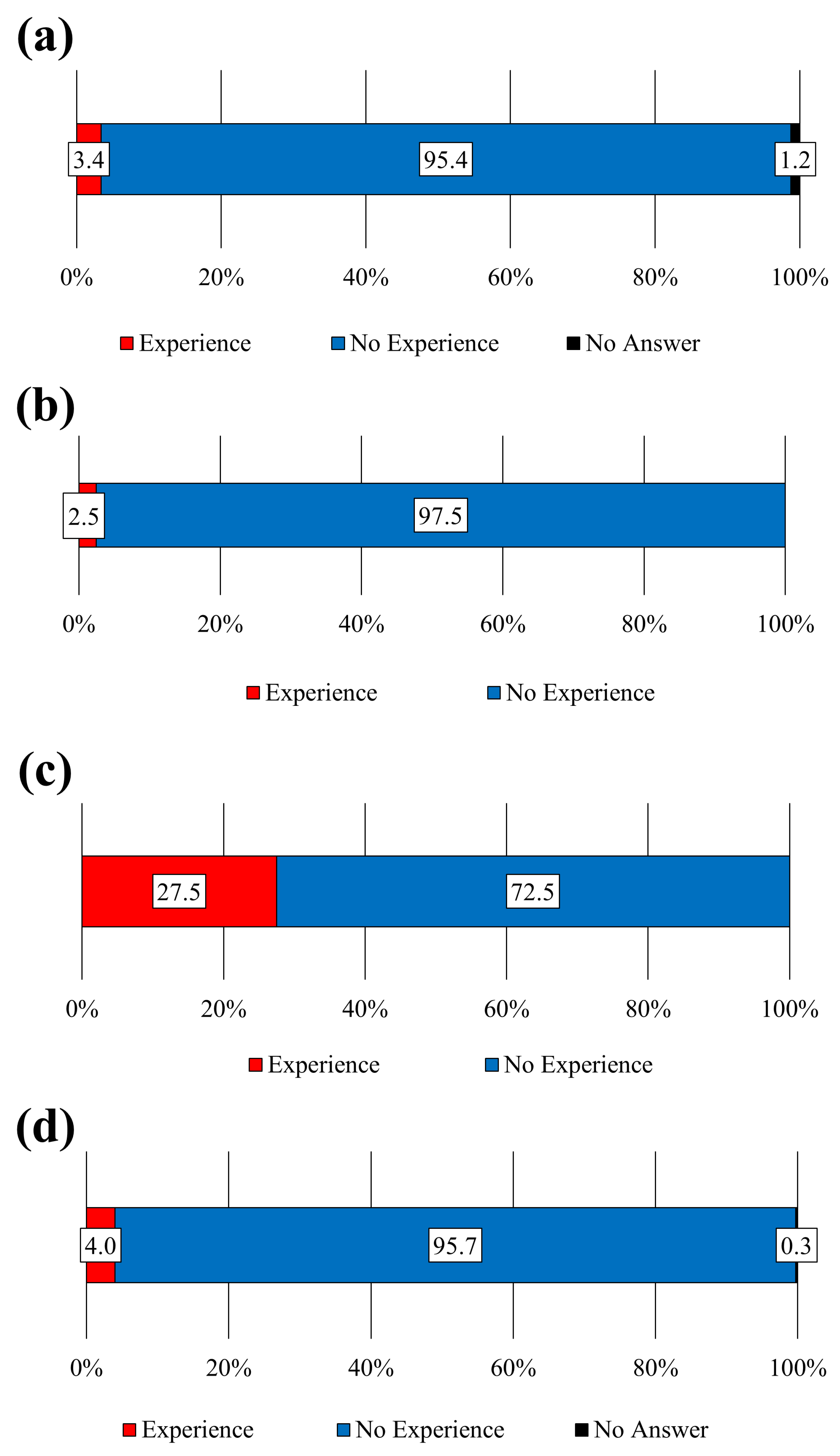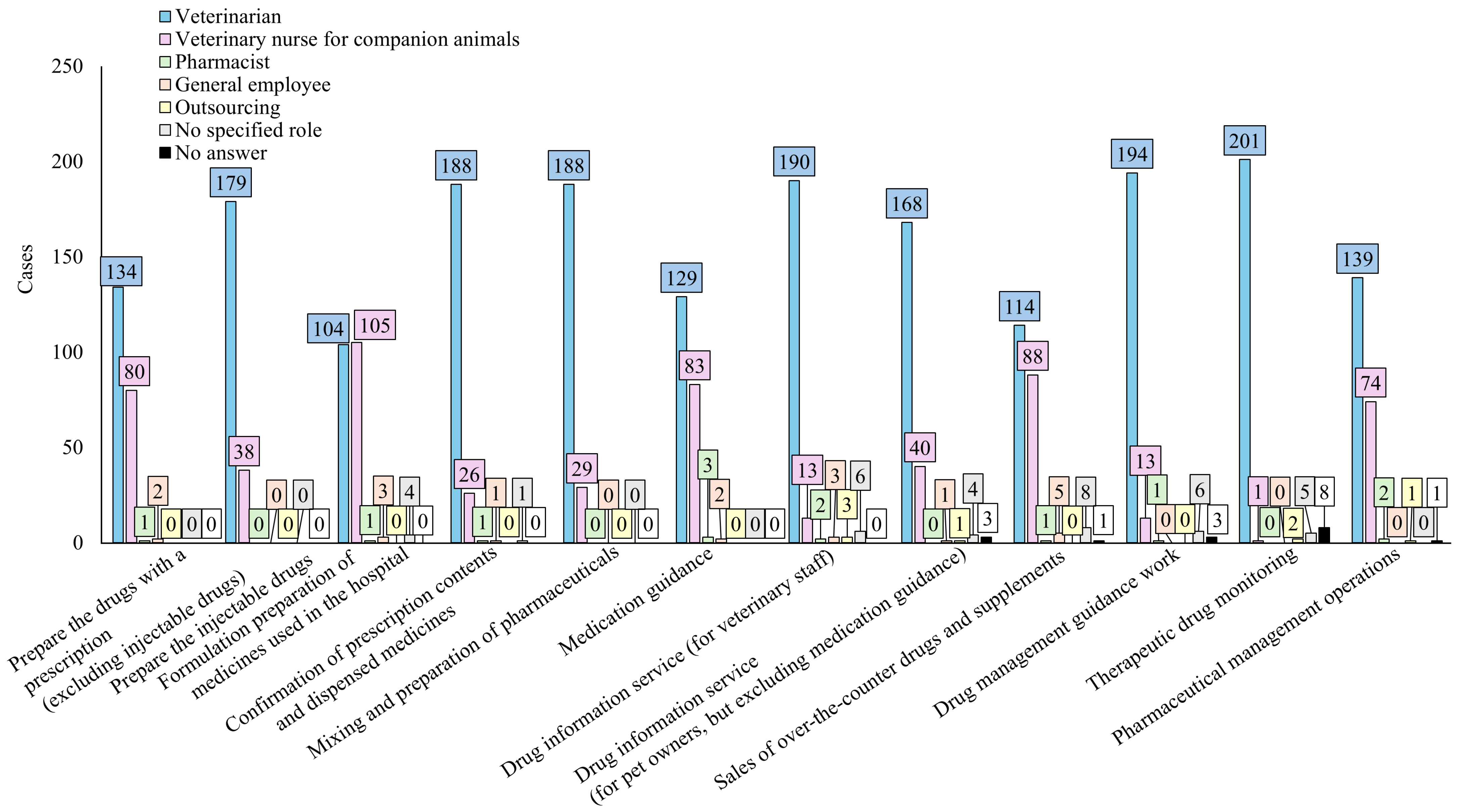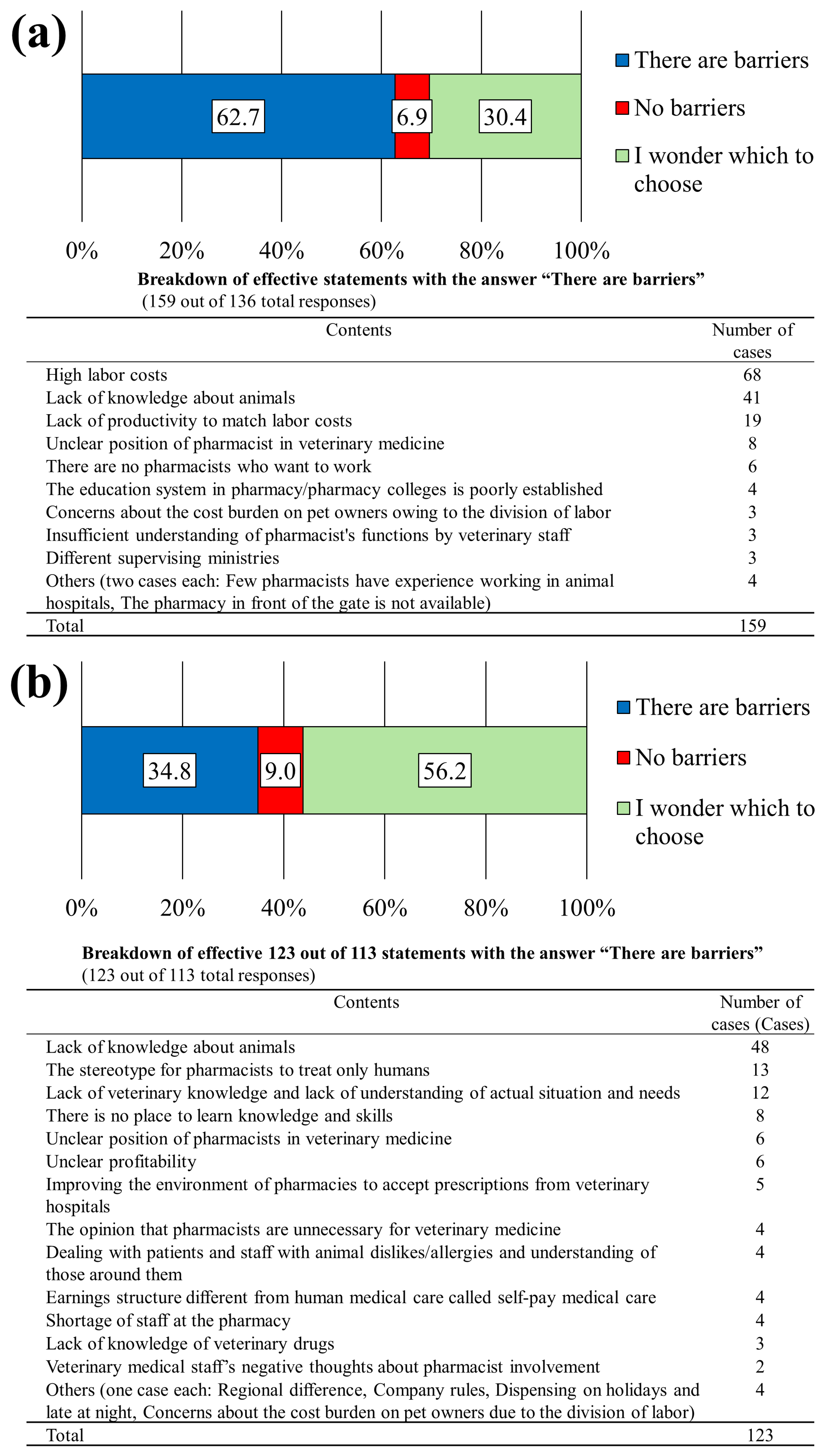Current Situation for Pharmacists in Japanese Veterinary Medicine: Exploring the Pharmaceutical Needs and Challenges of Veterinary Staff to Facilitate Collaborative Veterinary Care
Abstract
1. Introduction
2. Materials and Methods
2.1. Survey
2.2. Study Participants and Facilities
2.3. Data Collection
2.4. Statistical Analysis
3. Results
3.1. Number of Responses and Background of the Respondents
3.2. Pharmacy Involvement in Veterinary Medicine and the Actual Situation of Veterinary Hospital Operations
3.3. Perception of Pharmacists and Veterinary Hospital Staff Regarding Pharmacists’ Involvement in Companion Animal Healthcare
3.4. Pharmacists’ Perceptions of the Pharmaceutical Needs of Veterinary Staff and Their Contribution to Veterinary Medicine
3.5. Pharmacists’ and Veterinary Staff’s Attitudes Toward Problem-Solving and Barriers Faced by Pharmacists Engaging in Veterinary Care
3.6. Pharmacists’ Approaches to Gaining Veterinary Knowledge
4. Discussion
5. Conclusions
Supplementary Materials
Author Contributions
Funding
Institutional Review Board Statement
Informed Consent Statement
Data Availability Statement
Acknowledgments
Conflicts of Interest
References
- Pet Food Association of Japan. National Survey of Dog and Cat Ownership. 2023. Available online: https://petfood.or.jp/pdf/data/2023/3.pdf (accessed on 7 October 2024).
- Statistics Bureau; Ministry of Internal Affairs and Communications. The Number of Children in Japan—On the Occasion of Children’s Day—(From Population Estimates). 2023. Available online: https://www.stat.go.jp/data/jinsui/topics/pdf/topics137.pdf (accessed on 7 October 2024).
- Ministry of Agriculture, Forestry and Fisheries; Veterinary Medical Council. 2nd Planning Committee. Current Status of Small Animal Veterinary Medicine and Future Responses. 2019. Available online: https://www.maff.go.jp/j/council/zyuizi/keikaku/attach/pdf/r1_2-2.pdf (accessed on 7 October 2024).
- Price, L.W. Veterinary medicine and the pharmacists. I. Sulfonamides. SD J. Med. Pharm. 1956, 9, 470–471. [Google Scholar] [PubMed]
- Gochenauer, A.E.; Holmes, E.R.; Barber, K.E.; Forsythe, L.R. The current landscape of veterinary compounding in the pharmacy setting. Int. J. Pharm. Compd. 2019, 23, 422–427. [Google Scholar] [PubMed]
- Federal Trade Commission. Competition in the Pet Medications Industry Prescription Portability and Distribution Practices. 2015. Available online: https://www.ftc.gov/system/files/documents/reports/competition-pet-medications-industry-prescription-portability-distribution-practices/150526-pet-meds-report.pdf (accessed on 7 October 2024).
- Frankel, G.; Kusno, A.; Louizos, C. Five things every community pharmacist should know when dispensing for 4-legged patients. Can. Pharm. J. 2016, 149, 99–106. [Google Scholar] [CrossRef] [PubMed]
- Karriker, M.; Wiebe, V. Pharmacists in veterinary education: Bridging the gap. J. Vet. Med. Educ. 2006, 33, 248–252. [Google Scholar] [CrossRef] [PubMed]
- Shimamura, A. Insurance data in household animals. J. Vet. Epidemiol. 2012, 16, 67–73. [Google Scholar] [CrossRef][Green Version]
- Konno, T.; Suzuki, H.; Nakamura, H.; Murai, Y. Insights into current veterinary pharmaceutics for companion animals in Japan: A study based on data from the veterinary drug side effect database. Biol. Pharm. Bull. 2022, 45, 1225–1231. [Google Scholar] [CrossRef]
- Fredrickson, M.E.; Terlizzi, H.; Horne, R.L.; Dannemiller, S. The role of the community pharmacist in veterinary patient care: A cross-sectional study of pharmacist and veterinarian viewpoints. Pharm. Pract. 2020, 18, 1928. [Google Scholar] [CrossRef] [PubMed]
- Suzuki, M.; Kishimoto, K.; Nakanishi, H.; Fukushima, N. Survey on the safe handling of anticancer drugs in veterinary medicine. Jpn. J. Pharm. Health Care Sci. 2015, 41, 373–387. [Google Scholar] [CrossRef]
- Bennett, S.A.; Ruisinger, J.F.; Prohaska, E.S.; Steele, K.M.; Melton, B.L. Assessing pet owner and veterinarian perceptions of need for veterinary compounding services in a community pharmacy setting. Pharm. Pract. 2018, 16, 1224. [Google Scholar] [CrossRef]
- Japan Veterinary Medical Association. Small Animal Medical Fees. Available online: http://nichiju.lin.gr.jp/small/ryokin.html (accessed on 7 August 2024).
- Young, N.W.; Royal, K.D.; Park, M.; Davidson, G.S. Pharmacists’ knowledge of veterinary pharmacotherapy and the impact of an educational intervention. J. Pharm. Technol. 2018, 34, 244–251. [Google Scholar] [CrossRef] [PubMed]
- Purdue University Veterinary Hospital. Wasson Veterinary Pharmacy Residency. 2024. Available online: https://vet.purdue.edu/hospital/pharmacy-residency.php (accessed on 7 October 2024).
- PCCA Institute. Veterinary Compounding Course. 2019. Available online: https://www.pccarx.com.au/Portals/0/Documents/Institute/Vet%20-%20Winter%202019%20-%20PCCA%20Institute%20-%20201908%20-%2001mn.pdf (accessed on 7 October 2024).
- Society of Veterinary Hospital Pharmacists. Society Objectives. 2019. Available online: https://svhp.org/mission-objectives/ (accessed on 7 October 2024).
- American College of Veterinary Pharmacists. Standards of Practice for Pharmacists. 2019. Available online: https://vetmeds.org/standards-practice/ (accessed on 7 October 2024).
- Ministry of Education, Culture, Sports, Science, and Technology. Pharmaceutical Education Model Core Curriculum. 2021. Available online: https://www.mext.go.jp/content/20230227-mxt_igaku-100000058_01.pdf (accessed on 7 October 2024).
- Dayangku, S. Vet Pharmacy Malaysia: Controlled Medicine & Pet Healthcare Advice, Vulcan Post. 2020. Available online: https://vulcanpost.com/709122/vet-pharmacy-malaysia-pet-medicine-healthcare-advice/ (accessed on 17 November 2024).
- Besley, N.; Browne, P.; Park, M.; Pesheva, P.; Wong, K.; Hughes-Medlicott, N.J.; McDowell, A. Pharmacists in zoos? A qualitative study investigating the potential for pharmacist involvement in wildlife health care in Aotearoa, New Zealand. J. Am. Pharm. Assoc. 2023, 63, 825–831. [Google Scholar] [CrossRef] [PubMed]
- Davidson, G. Veterinary compounding: Regulation, challenges, and resources. Pharmaceutics 2017, 9, 5. [Google Scholar] [CrossRef] [PubMed]
- World Health Organization. One Health. 2024. Available online: https://www.who.int/health-topics/one-health (accessed on 7 October 2024).










| Characteristic | N (%) | Total | |
|---|---|---|---|
| Types of professionals | Veterinarian | 181 (83.4) | 217 |
| Veterinary nurse for companion animals | 34 (15.7) | ||
| Pharmacist | 2 (0.9) | ||
| Region | Hokkaido | 11 (5.1) | 217 |
| Tohoku | 21 (9.7) | ||
| Kanto | 83 (38.3) | ||
| Chubu | 30 (13.8) | ||
| Kinki | 38 (17.5) | ||
| Chugoku/Shikoku | 17 (7.8) | ||
| Kyushu/Okinawa | 15 (6.9) | ||
| No answer | 2 (0.9) | ||
| Affiliation | Personal business | 97 (44.7) | 217 |
| Corporate management | 114 (52.5) | ||
| University hospital | 5 (2.3) | ||
| No answer | 1 (0.5) | ||
| Number of employees | 1–3 | 32 (14.7) | 217 |
| 4–6 | 55 (25.3) | ||
| 7–9 | 39 (18.0) | ||
| 10–20 | 51 (23.5) | ||
| ≥21 | 39 (18.0) | ||
| No answer | 1 (0.5) | ||
| Status of neighboring facilities | There is a pharmacy nearby | 104 (47.9) | 217 |
| There is NO pharmacy nearby | 112 (51.6) | ||
| No answer | 1 (0.5) | ||
| Characteristic | N (%) | Total | |||
|---|---|---|---|---|---|
| Animal hospital staff | Qualifications other than veterinarian license | Pharmacist | 7 | 22 | |
| Japanese Animal Hospital Association-certified veterinarian | 6 | ||||
| Veterinarian certified by various societies | 4 | ||||
| Doctor of veterinary medicine | 1 | ||||
| Narcotics license for veterinarians | 1 | ||||
| Acupuncturist | 1 | ||||
| Public health laboratory technologist | 1 | ||||
| Registered salesclerk | 1 | ||||
| Qualifications other than veterinary nurse for companion animal license | Pharmacist | 1 | 3 | ||
| Medical technologist | 1 | ||||
| Japan Kennel Club-certified pet nurse | 1 | ||||
| Qualifications other than pharmacist’s license | - | 0 | 0 | ||
| Pharmacy and drug store staff | Medical qualifications other than pharmacist’s license | Licensed by the Japan Pharmacists’ Education Center | 43 | 75 | |
| Sports pharmacist | 7 | ||||
| Practical training certified guidance pharmacist | 6 | ||||
| Medical technologist | 4 | ||||
| Supplement advisor | 3 | ||||
| Chinese herbal medicine certified pharmacist | 2 | ||||
| Public health laboratory technologist | 2 | ||||
| Care manager | 2 | ||||
| Outpatient cancer treatment certified pharmacist | 1 | ||||
| Regional pharmacy care pharmacist | 1 | ||||
| Traditional Chinese physician | 1 | ||||
| Certified diabetes educator in Japan | 1 | ||||
| Certified infertility counselor | 1 | ||||
| Registered salesclerk | 1 | ||||
| Qualifications and certifications held in the field of veterinary medicine | Veterinarian | 1 | 5 | ||
| Pet care worker | 1 | ||||
| Type 1 registration of animal handling business | 1 | ||||
| Pet breeding manager, second grade | 1 | ||||
| Japanese Animal Hospital Association-certified family dog instructor | 1 | ||||
| Characteristic | N (%) | Total | |
|---|---|---|---|
| Region | Hokkaido | 16 (4.9) | 324 |
| Tohoku | 37 (11.4) | ||
| Kanto | 89 (27.5) | ||
| Chubu | 42 (13.0) | ||
| Kinki | 37 (11.4) | ||
| Chugoku/Shikoku | 61 (18.8) | ||
| Kyushu/Okinawa | 42 (13.0) | ||
| Affiliation | Pharmacies (whose main business is dispensing prescriptions) | 292 (90.1) | 324 |
| Kampo pharmacies | 17 (5.3) | ||
| Pharmacies (other than those listed above) | 2 (0.6) | ||
| Drug stores | 9 (2.8) | ||
| Companies handling veterinary drugs | 1 (0.3) | ||
| No answer | 3 (0.9) | ||
| Number of employees | 1–3 | 63 (19.5) | 324 |
| 4–6 | 119 (36.7) | ||
| 7–9 | 60 (18.5) | ||
| 10–20 | 65 (20.1) | ||
| ≥21 | 5 (1.5) | ||
| No answer | 12 (3.7) | ||
| Status of neighboring facilities | There is an animal hospital nearby | 57 (17.6) | 324 |
| There is NO animal hospital nearby | 265 (81.8) | ||
| No answer | 2 (0.6) | ||
| Affiliation | Region | Specific Comments |
|---|---|---|
| Community pharmacy | Tohoku | At the owner’s request, ursodeoxycholic acid was dispensed as directed by a veterinarian. Medication instructions were given by the veterinarian. |
| Community pharmacy | Tohoku | An owner visited the pharmacy after receiving an out-of-hospital prescription. Although it was difficult to evaluate the prescription content, there was no significant deviation from the human dose. The cost of dispensing was all paid by me. It seemed that the cost was lower compared to that at the animal hospital. |
| Kampo pharmacies | Tohoku | After consulting with a veterinarian, the owner came to the pharmacy. Kampo-Hochuekkito and Kampo-Rikkunshito were prepared to reduce the side effects of chemotherapy. |
| Community pharmacy | Kanto | Dispensed prescription drugs for pet dogs. |
| Companies handling veterinary drugs | Kanto | I have experience working as a pharmacist in a veterinary hospital. If there was any doubt about the prescription, we confirmed and consulted with a veterinarian and prepared it in the hospital. I also gave the owner instructions on how to use the medication. |
| Kampo pharmacies | Kanto | There was a consultation/request from an animal hospital one station away. After mutual consideration, a Chinese herbal medicine was dispensed. Medication histories were recorded at both facilities. The expenses were billed to the animal hospital. |
| Kampo pharmacies | Chubu | A nearby veterinary hospital asked us to provide an eye drop (antibacterial drug) that was not used in the hospital. Prescription details were communicated to the veterinarian in advance. The owner brought the issued out-of-hospital prescription. The weight of the pet was replaced with that of a human to evaluate the adequacy of the prescription. Medication history management and medication counseling were given to the owner in the same manner as in the case of humans. |
| Community pharmacy | Chubu | Dispensed at the request of the owner who brought the out-of-hospital prescription. I could not provide proper medication counseling owing to my lack of knowledge about animals. |
| Pharmacies (other than those listed above) | Chugoku/Shikoku | The pharmacist consulted with a veterinarian about the medicine for a pet dog and dispensed it. |
| Community pharmacy | Kyusyu/Okinawa | The pharmacist had experience working at a veterinary facility. The pharmacist oversaw the delivery of veterinary medicines, inspection, filing, and medicine management. |
| Animal Hospital Staff | Pharmacy/Drug Store Staff | |||
|---|---|---|---|---|
| N (%) | Adjusted Residuals | N (%) | Adjusted Residuals | |
| Have you ever thought about pharmacists being involved in companion animal veterinary medicine? | ||||
| Yes | 124 (57.1) | 2.68 ** | 147 (45.4) | –2.68 ** |
| No | 84 (38.7) | −3.00 ** | 168 (51.9) | 3.00 ** |
| Neither option can be selected | 9 (4.2) | 0.87 | 9 (2.7) | –0.87 |
| Total | 217 (100) | 324 (100) | ||
| Animal Hospital Staff | Pharmacy/Drug Store Staff | |||
|---|---|---|---|---|
| N (%) | Adjusted Residuals | N (%) | Adjusted Residuals | |
| Would you like to work with a pharmacist/veterinarian or veterinary nurse for companion animals in the future? | ||||
| I strongly agree | 23 (10.6) | −1.71 | 51 (15.7) | 1.71 |
| If I dare to answer, I think so | 58 (26.7) | −2.07 * | 114 (35.2) | 2.07 * |
| Neither option can be selected | 66 (30.4) | −0.56 | 106 (32.7) | 0.56 |
| If I dare to answer, I do not think so | 55 (25.4) | 3.37 ** | 45 (13.9) | –3.37 ** |
| I never think so | 15 (6.9) | 2.51 * | 8 (2.5) | –2.51 * |
| Total | 217 (100) | 324 (100) | ||
Disclaimer/Publisher’s Note: The statements, opinions and data contained in all publications are solely those of the individual author(s) and contributor(s) and not of MDPI and/or the editor(s). MDPI and/or the editor(s) disclaim responsibility for any injury to people or property resulting from any ideas, methods, instructions or products referred to in the content. |
© 2024 by the authors. Licensee MDPI, Basel, Switzerland. This article is an open access article distributed under the terms and conditions of the Creative Commons Attribution (CC BY) license (https://creativecommons.org/licenses/by/4.0/).
Share and Cite
Konno, T.; Suzuki, H.; Suzuki, N.; Okada, K.; Nishikawa, Y.; Kikuchi, D.; Nakamura, H.; Murai, Y. Current Situation for Pharmacists in Japanese Veterinary Medicine: Exploring the Pharmaceutical Needs and Challenges of Veterinary Staff to Facilitate Collaborative Veterinary Care. Pharmacy 2024, 12, 179. https://doi.org/10.3390/pharmacy12060179
Konno T, Suzuki H, Suzuki N, Okada K, Nishikawa Y, Kikuchi D, Nakamura H, Murai Y. Current Situation for Pharmacists in Japanese Veterinary Medicine: Exploring the Pharmaceutical Needs and Challenges of Veterinary Staff to Facilitate Collaborative Veterinary Care. Pharmacy. 2024; 12(6):179. https://doi.org/10.3390/pharmacy12060179
Chicago/Turabian StyleKonno, Taisuke, Hiroyuki Suzuki, Naoto Suzuki, Kouji Okada, Yosuke Nishikawa, Daisuke Kikuchi, Hitoshi Nakamura, and Yuriko Murai. 2024. "Current Situation for Pharmacists in Japanese Veterinary Medicine: Exploring the Pharmaceutical Needs and Challenges of Veterinary Staff to Facilitate Collaborative Veterinary Care" Pharmacy 12, no. 6: 179. https://doi.org/10.3390/pharmacy12060179
APA StyleKonno, T., Suzuki, H., Suzuki, N., Okada, K., Nishikawa, Y., Kikuchi, D., Nakamura, H., & Murai, Y. (2024). Current Situation for Pharmacists in Japanese Veterinary Medicine: Exploring the Pharmaceutical Needs and Challenges of Veterinary Staff to Facilitate Collaborative Veterinary Care. Pharmacy, 12(6), 179. https://doi.org/10.3390/pharmacy12060179






